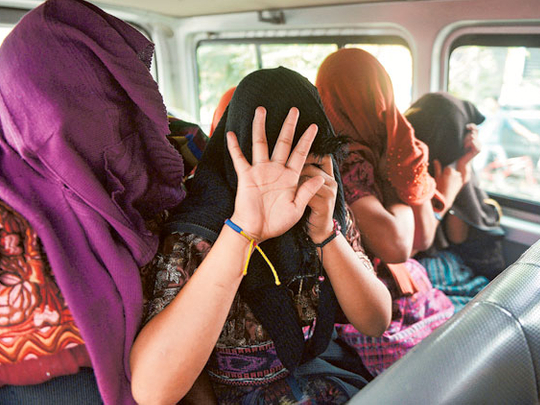
Dubai: An estimated 30 million people worldwide are living in modern-day slavery, according to the inaugural Global Slavery Index published on Thursday.
The index, compiled by the Walk Free Foundation, said that while India by far had the largest number of enslaved people, the problem was most prevalent in the west African nation of Mauritania, where four per cent of the population was deemed to be held in slavery.
There are an estimated 14 million slaves in India and a further 2.1 million in Pakistan. The foundation’s definition of modern slavery includes slavery itself, plus slavery-like practices — such as debt bondage, forced marriage and the sale or exploitation of children — human trafficking and forced labour.
The WFF hopes the annual index will help governments to monitor and tackle what it calls a “hidden crime”.
“A lot of governments won’t like hearing what we have to say,” chief executive Nick Grono told AFP.
“Those governments that want to engage with us, we will be very open to engaging and looking at ways in which we can better measure the issue of modern slavery.”
Established in May last year, the WFF is a 20-strong team based in Perth on the Australian west coast, founded by philanthropists Andrew Forrest — the chairman of Fortescue Metals Group — and his wife Nicola.
It has the backing of former US secretary of state Hillary Clinton, Britain’s ex-prime minister Tony Blair, current Australian PM Tony Abbott and philanthropists Bill Gates, Richard Branson and Mo Ebrahim.
“A lot of people are very surprised to hear that slavery still exists,” said Grono, explaining how many people assume it ended when the Atlantic slave trade was abolished in the 1800s.
“What modern slavery is a situation that reflects all of the characteristics of slavery of past centuries,” he said.
“People are controlled by violence. They are tricked or they are forced into jobs or situations where they are economically exploited. They live on no pay or base subsistence pay and they’re not free to leave.”
The foundation has pulled together the best available experts in the field, data from respected outside sources and their own analysis to compile the 162-country index.
“It is tough because slavery is a hidden crime, so it’s difficult to get data. It’s a bit like trying to measure domestic violence or drug trafficking,” Grono admitted.
“We’ve very conscious that it’s very hard to measure this.”
The countries with the highest prevalence of modern slavery were Mauritania, Haiti, Pakistan, India, Nepal, Moldova, Benin, Ivory Coast, Gambia and Gabon. Moldova — once part of the Soviet Union — was the only European nation in the top 10.
The index describes Mauritania as a nation with “deeply entrenched hereditary slavery”, while “people in slavery may be bought and sold, rented out and given away as gifts”.
Grono said the inherited slave status was “very shocking”.
“In Mauritania, kids are born into slavery,” he explained.
“Women and men are enslaved and their children are often forced into a situation of domestic servitude or forced to work in the fields.”
Russia came 49th, China 84th, United States 134th, France 139th and Britain joint bottom on 160.
The report estimated that 72 per cent of people in modern slavery live in Asia.
In India, “by far the largest proportion of this problem is the exploitation of Indian citizens within India itself, particularly through debt bondage and bonded labour”, the report said.
The estimated 2.9 million people in modern slavery in China “includes the forced labour of men, women and children in many parts of the economy, including domestic servitude and forced begging, the sexual exploitation of women and children, and forced marriage,” said the report.
Among the top 10, the WFF said Moldova and Ivory Coast were working hard to address the issue, but efforts in the top three — Mauritania, Haiti and Pakistan — are “token at best and non-existent at worst”, the report said.
Grono said: “Modern slavery is an issue that’s getting an awful lot of attention. It’s illegal everywhere and it’s absolutely abhorrent.
“I think once we start pointing out the scale of the problem on a country by country basis, policy makers will react.
“Slavery exists in every country in the world.”
Chattel slavery is common in Mauritania, meaning that slave status is passed down through generations. After Mauritania, slavery is most prevalent by population in Haiti, where a system of child labour known as “restavek” encourages poor families to send their children to wealthier acquaintances, where many end up exploited and abused.
Pakistan, India, Nepal, Moldova, Benin, Ivory Coast, Gambia and Gabon have the next highest prevalence rates.
At the other end of the scale, Iceland has the lowest estimated prevalence with fewer than 100 slaves.
Next best are Ireland, Britain, New Zealand, Switzerland, Sweden, Norway, Luxembourg, Finland and Denmark, although researchers said slave numbers in such wealthy countries were higher than previously thought.
“They’ve been allocating resources against this crime according to the tiny handful of cases that they’ve been aware of,” said Kevin Bales, lead researcher and a professor at the Wilberforce Institute for the Study of Slavery and Emancipation at Hull University.
“Our estimates are telling them that the numbers of people in slavery — whether it’s in Great Britain or Finland or wherever — in these richer countries actually tends to be about six to 10 times higher than they think it is.”
Compiled from agencies













